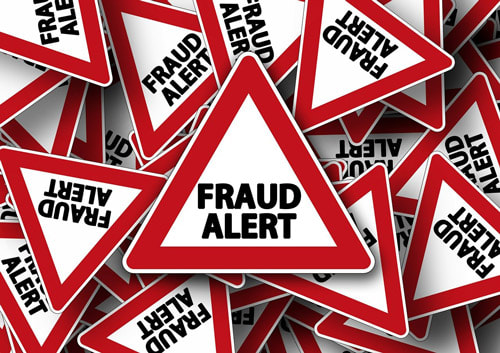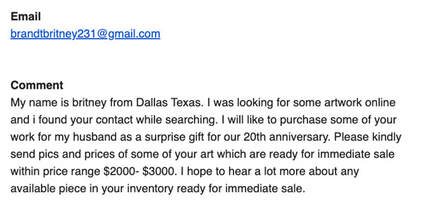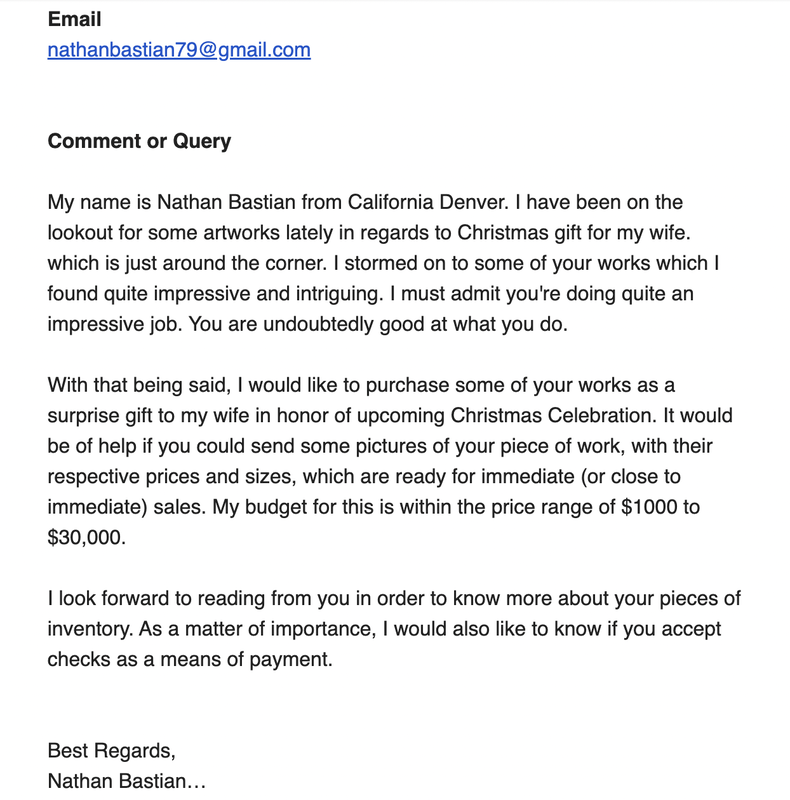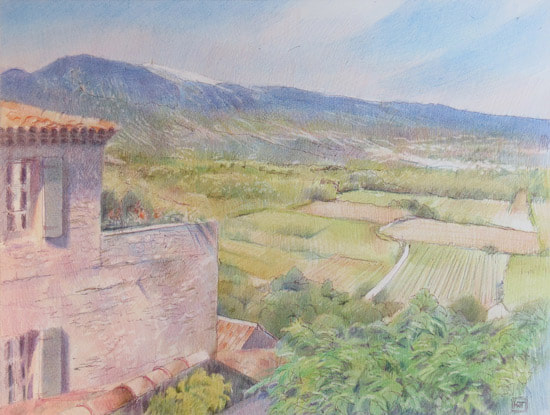- Home
- NEWS
-
PRACTICE
-
MARKETING
- How to write an Artist's Statement >
- How to write an Artist's Resume or CV >
- How to sign a painting, drawing or fine art print
- Business Cards for Artists
- How to write a press release for an artist
- The Private View Invitation
- Publicity for Juried Exhibitions
- Websites for Artists >
- Image & Video sizes for Social Media Sites
- How to be mobile-friendly
-
SELL ART
- FRAME ART
-
SHIP ART
-
COPYRIGHT
-
MONEY & TAX
- About + Help
- BANKING
Below you'll find links to advice and information about
how to spot a scam, fake art and/or fraudulent activity related to art and artists and art.
how to spot a scam, fake art and/or fraudulent activity related to art and artists and art.
|
Below you will find summaries and links to relevant information relating to:
COMING SOON
|
See also the section on COPYRIGHT and the pages about
What are Art Scams, Frauds and Cyber Crimes?
Fraud is when trickery is used to gain a dishonest advantage, which is often financial, over another person. Cyber crime is any criminal act dealing with computers and networks.
What is fraud and cyber crime | Action Fraud
The ways and means of scamming artists and art collectors are numerous and multiplying. This page will attempt to highlight some of the more obvious scams, fraudulent activities and cyber crimes which happen in the art world.
Very few textbooks about the art business consider the different types of fraudulent activity which artists - or art collectors - may encounter.
Very few textbooks about the art business consider the different types of fraudulent activity which artists - or art collectors - may encounter.
|
Common Art Scams include
|
Common Art Frauds involves:
|
Common Art Cyber Crimes involve:
|
Sadly the combination of inexperience in business (lots of us are just starting out), susceptibility to flattery (because we make our own products) and working alone (no one to offer a double check) means that we will continue to be seen as a soft target for those who make their living by deception. |
I am [name}, an artist from [name} and I have recently faced a fraud by an [individual] that claimed to have a gallery and make exhibitions and publish an art catalogue. I gave him money for the art catalogue, under a lot of pressure by his side, and then he disappeared. I made a small research and found out more artists over the world that had the same problem with the same person. Is there anything we can do in order to stop him from taking artists money and disappear? Is there anything that you would recommend? |
|
REFERENCE:
|
AND
|
Websites which "out" scams
|
There are three sorts of websites. These are websites which are:
Please Contact Me with any recommendations about websites you have found useful for checking out scams and fraud. |
REFERENCE
|
How to spot an Art Scam
How to spot a fake, fraudulent or scam website
Those who attempt to market and sell fake goods or services very often also have a fake website.
Artists selling art from their own websites or the websites of third parties need to be careful they are not displaying any of the RED FLAGS for a fraudulent website
- These have a number of characteristics - see the RED FLAGS below
- Only the very sophisticated fraudsters go to the trouble of producing a convincing website which passes all RED FLAG checks.
Artists selling art from their own websites or the websites of third parties need to be careful they are not displaying any of the RED FLAGS for a fraudulent website
|
RED FLAGS include:
|
How to avoid a fake website
REFERENCE
|
How to spot a Vanity Gallery
CHECK OUT:
- the characteristics listed on The Vanity Gallery webpage on this website
- How's my Dealing? - Galleries - includes reviews by artists who consider they have been scammed
How to spot Fake Fairs and Art Fair Scams
|
You need to be very wary of:
Art fairs and art fair directories can attract negative comments from artists because what has been delivered falls far short of what was promised and paid for. Fake Art Fairs are created by people with no experience of the business who recognise that artists wanting to sell their art will pay for a booth - and all "the extras". RED FLAGS include
CHECK OUT:
|
REFERENCE:
Organisations such as Event Fair, FairGuide.com/Construct Data Verlag and International Fairs Directory (Portugal) are targeting exhibitors with their misleading directory services. |
How to avoid a fake art fair
- JOIN one of the specialist art groups which exist to support art fair artists and protect them from the scammers. These are:
- Art Fair Insiders (Online Community for Art Fair Artists) - which includes the Art Fair Insiders Discussion Forum
- Art Fair Buddies (UK Facebook Group) - this includes reviews of art fairs, and recommendations of art fairs and services
- REVIEW the Art fairs Section of How's My Dealing for the name of the Art Fair
- CHECK evidence of any previous art fair held by the individual or the organisation
- CONTACT the local business bureau to find out if they have had any dealings with them before
- BEWARE some individuals constantly reinvent under new company names - check out UK individuals on Companies House records for individuals.
- CHECK whether any of the key individuals have previously been bankrupt.
- NEVER EVER pay any money to any art fair or fair directory before thoroughly researching the enterprise - and the names of individuals behind it. Establish and check out whoever is behind the operation (including, in the UK their VAT registration number)
How to spot fake goods or services
Intellectual property crime is committed when someone manufactures, sells or distributes counterfeit or pirated goods, such as such as patents, trademarks, industrial designs or literary and artistic works, for commercial gain.
Artists buy goods and services as well as sell them. They need to be aware of the different ways they can be scammed by fraudsters.
|
RED FLAGS for fake goods (e.g. art materials) include:
RED FLAGS for fake services (e.g. tuition / art fairs / art galleries / online art markets) include:
|
REFERENCE
|
|
|
|
How to spot - and avoid - an email / internet scam
|
The most popular type of scam related to the sale of artwork involves email.
BOTTOM LINE: They are NOT interested in your artwork; they want to steal your money. |
Below I
|
|
In summary this involves a person who pretends they want to:
|
BUT the individual
|
An artist talks about email scams below.
|
RED FLAGS include:
|
How to avoid being scammed by an email scammer
|
If you are a social responsible citizen can I suggest you REPORT
- abuse of the email address to Google
- internet crime (in the USA) to the Internet Crime Complaint Centre (IC3)
- report potentially fraudulent 'normal' mail to Royal Mail or your local post service.
REFERENCE: EMAIL ART SCAMS
- What an email scam sent to artists looks like | Art Business Info for Artists - a summary of what to look out for
- How to report a spam email address - This post is about a few things you can do to stop spam and stop scammers
- Don't be Fooled by Email Art Scams: How to Spot and Avoid Fraud | Artwork Archive
- Anatomy of a Email Art Scam | RedDotBlog - by a gallery owner who provides lots of details about how scammers work and shows you the documentation. This gallery owner likes keeping scammers on the hook!
- How to Recognise an Art Scam | Visual Artists Ireland
- How to spot an art scam | Makersbusinesstoolkit - focuses on 3 art scams - including the overpayment scam
- Bank transfer scams rise by 40% - tips for how to stay safe | Moneywise (2019) identifies various ways in which frauds are attempted using bank transfers
- How's my Dealing - Mail Scams - focuses on email scams
- how to report a gmail account | Wikihow - re. somebody who uses gmail for scamming
- This is a link to the gmail abuse form
|
However you can be TOO cautious......
The image on the right is a coloured pencil drawing I did for an American lady who emailed me after spotting a sketch on my sketchbook blog and asked if I could create a drawing of the same view. She wanted to give her cycle loving husband a picture of Mont Ventoux in France - the killer climb in the Tour de France - for his birthday. Absolutely no problems with this commission. |
How to avoid being the victim of an Art Print Scam
- or looking like you are a scammer!
Since the dawn of the internet, the problem of phony art being sold has only grown, experts say, and the primary coin of the forgery realm has long been the fake print, which is relatively easy to create, often difficult to detect and typically priced low enough to attract undiscriminating novice buyers.
Art Experts Warn of a Surging Market in Fake Prints | New York Times
|
There are two types of markets for art prints:
|
There are three types of scams in the art print marker
"Limited edition" strictly speaking is a terms which should be limited to fine art prints created as original art ONLY - and never used for reproduction prints. Since creating more of the latter is as simple as loading the printer with paper and ink and pressing the button. Some may reprint the image at a slightly different size - and start selling a "limited edition" all over again. |
The third type of scam is that involving reproductions of fine art prints by well known artists.
There are many more prints in circulation by some artists than they ever produced.
Print collectors are seen as "easy pickings" by some disreputable dealers.
There are many more prints in circulation by some artists than they ever produced.
Print collectors are seen as "easy pickings" by some disreputable dealers.
The anonymity of many sellers on such auction-based sites like eBay make the appearance of fakes a matter of course, but there are a rising number of fixed-price portals who are also willing to be less than scrupulous with the works they have on offer.
- What To Watch Out For When Buying Art Online | fineartmultiple
|
Misrepresenting artwork (1)
If you are buying an art print by a named / well known artist you need to be very, very careful. The art market is full of crooks who will try and scam art collectors by selling them a forged fine art print. They will try and make it look as near as possible to the real thing. fakes.... are typically photomechanical reproductions of the originals. The forgeries are made by people with no connection to the artist and are sold as his or her work; they will often be accompanied by phony signatures from the artist or bogus certificates of authenticity. |
Misrepresenting artwork (2)
Artists often use "limited edition" to describe their reproduction prints - particularly those who like the idea of increasing the price of their work, However there is no way you can ever ascertain whether they printed only the number in the edition. An open edition print is one which keeps being printed for a long as it sells. IGNORE the notion of limited edition and just buy a reproduction print if you like it |
Statisticians at the George Washington University in 2013 estimated that 91 percent of Henry Moore drawings available on eBay at that time were fake.
Art Experts Warn of a Surging Market in Fake Prints | New York Times
Dali, now 82 and infirm, is one of “the big three” artists whose names most frequently engender complaints, art experts said. The others are Joan Miro and Chagall. Prints attributed to Pablo Picasso and Alexander Calder also generate many complaints.
"Limited edition!"
"Rare special edition!"
"Collectors’ edition long out off print!"
"Rare antique" (from 1989)
"Strictly limited print on hand-made paper"
"Limited luxury edition"
In this case, statements with a positive connotation are used for sales purposes. In reality, it is the copy of an original by means of photomechanical reproduction (and thus an art print). Often such prints are "limited" like the issue of a daily newspaper. Often these prints are marketed with handwritten numberings (implying the artist did the numbering him- or herself), hand-made paper is supposed to sell better, and frequently dubious "certificates of authenticity" or "expert opinions" are added.
- Buying original graphic art via the internet | original-prints.com
Printers who steal
I learned about this type of scam very early on from a friend who produced very popular cat drawings and sold them as giclee prints. One gallery she was doing business with was creating additional giclee prints and selling them as a sideline.
One way to avoid this is to keep complete control over the printing. If you create a lot of prints, it could be worthwhile to invest in a quality printer.
I learned about this type of scam very early on from a friend who produced very popular cat drawings and sold them as giclee prints. One gallery she was doing business with was creating additional giclee prints and selling them as a sideline.
One way to avoid this is to keep complete control over the printing. If you create a lot of prints, it could be worthwhile to invest in a quality printer.
How to avoid being the victim of an art print scam
|
AS A BUYER (or seller)
|
AS AN ARTIST
|
Art forgery is the creating and selling of works of art which are falsely credited to other, usually more famous artists.
- Art Forgery | Wikipedia
REFERENCE: ART PRINT SCAMS
- Art Forgery | Wikipedia
- Art Experts Warn of a Surging Market in Fake Prints | New York Times - Spurred by advances in photomechanical reproduction, forgers are increasingly selling unauthorized copies of famous works on the internet, and elsewhere.
- CAVEAT EMPTOR : When It Comes to Fine-Art Prints, Let the Buyer Beware | Los Angeles Times
- What To Watch Out For When Buying Art Online | fineartmultiple
- Buying original graphic art via the internet | original-prints.com - EXCELLENT article with lots of good tips for what to look out for to avoid being diddled by fraudsters.
- Beware of Art Print Scams | Judy Rey Wasserman - Post Conceptual UnGraven Image
How to be safe when paying for goods or services online
|
How to be "better safe than sorry" online
What follows is a summary of the recommended guidelines produced by Europol who are seeking to reduce the amount of online frauds and scams. |
THE GOLDEN RULES DO
HOW-TO GUIDE | Europol |
Artists who sell their art online ALSO need to be sure they are also following all the good practice recommendations
REFERENCE:
- DOWNLOAD the Golden Rules - Safe Online Shopping (EN) (Europol)
- Get Safe Online - a public / private sector partnership supported by HM Government and leading organisations in banking, retail, internet security and other sectors.
Art Fakes, Fraud and Forgeries
Art fraud, the deliberately false representation of the artist, age, origins, or ownership of a work of art in order to reap financial gain. Forgery of a famous artist’s work is the best-known kind of art fraud, but fraud may also result from the knowing misattribution of the age or origin of a work of art
Art Fraud | britanicca.com
The majority of art crimes that the police focus on relate to theft - and fraud and forgeries seem to come low on the list of priorities (in the uSA). Mainly because the police forces lack expertise or access to expertise in such matters.
Art Fraud - generally
|
False Impressions: The Hunt for Big-Time Art Fakes by Thomas Hoving
This is a big, broad book on art fakes, fakers, and suckers written in Hoving's signature style - amusing, wicked, and mischievous. From the shroud of Turin to Pre-Columbian pottery, Hoving covers the biggest, the best, the most embarrassing, and the most costly forgeries - most never before published, some he himself collected. He explains the differences between out-right forgeries and works so overly restored and tarted up the result is tantamount to forgery. (Publisher) Publisher: Simon and Schuster
Publication date: Illustrated edition (19 Nov. 1982) Language : English Paperback : 384 pages BUY THIS BOOK False Impressions: The Hunt for Big-Time Art Fakes
False Impressions: The Hunt for Big-Time Art Fakes
|
REFERENCE: ART FRAUD & FORGERY
- Art Forgery | Wikipedia
- Art Fraud | britanicca.com
- Fakes, forgeries and dirty deals | Fraud Magazine - Global fight against amorphous art fraud
Banner/Feature Image: Gerd Altmann from Pixabay |
|
ABOUT ART BUSINESS INFO. FOR ARTISTS
This website aims to provide a compendium of resources about the art business for artists. Please read "PLEASE NOTE"
It helps artists learn how to do better at being business-like, marketing and selling their art and looking after their financial security.
This website aims to provide a compendium of resources about the art business for artists. Please read "PLEASE NOTE"
It helps artists learn how to do better at being business-like, marketing and selling their art and looking after their financial security.
|
Copyright: 2015-2021 Katherine Tyrrell | Making A Mark Publications
- all rights reserved If you've got any suggestions for what you'd like to see on this website please send me your suggestion
|
PLEASE NOTE:
1) Content and the law change all the time. It's impossible to keep up with it if you're not working on the topic full time. 2) I research topics carefully. However, I am totally unable to warrant that ANY and/or ALL information is
|
3) Hence all information I provide comes without any LIABILITY whatsoever to you for any choices you make.
4) This website is FREE FOR YOU but not for me. Links to books are Amazon Affiliate links. Buying a book via this website means I get a very small payment which helps to fund and maintain this website. .I much appreciate any support your provide. Adverts are provided by Google AdSense - but the adverts do not mean I endorse the advertiser. |
- Home
- NEWS
-
PRACTICE
-
MARKETING
- How to write an Artist's Statement >
- How to write an Artist's Resume or CV >
- How to sign a painting, drawing or fine art print
- Business Cards for Artists
- How to write a press release for an artist
- The Private View Invitation
- Publicity for Juried Exhibitions
- Websites for Artists >
- Image & Video sizes for Social Media Sites
- How to be mobile-friendly
-
SELL ART
- FRAME ART
-
SHIP ART
-
COPYRIGHT
-
MONEY & TAX
- About + Help
- BANKING




